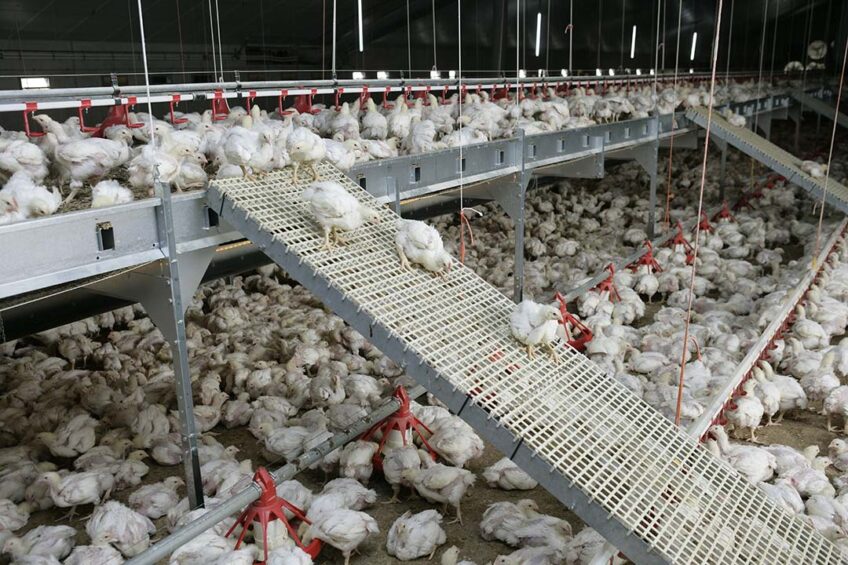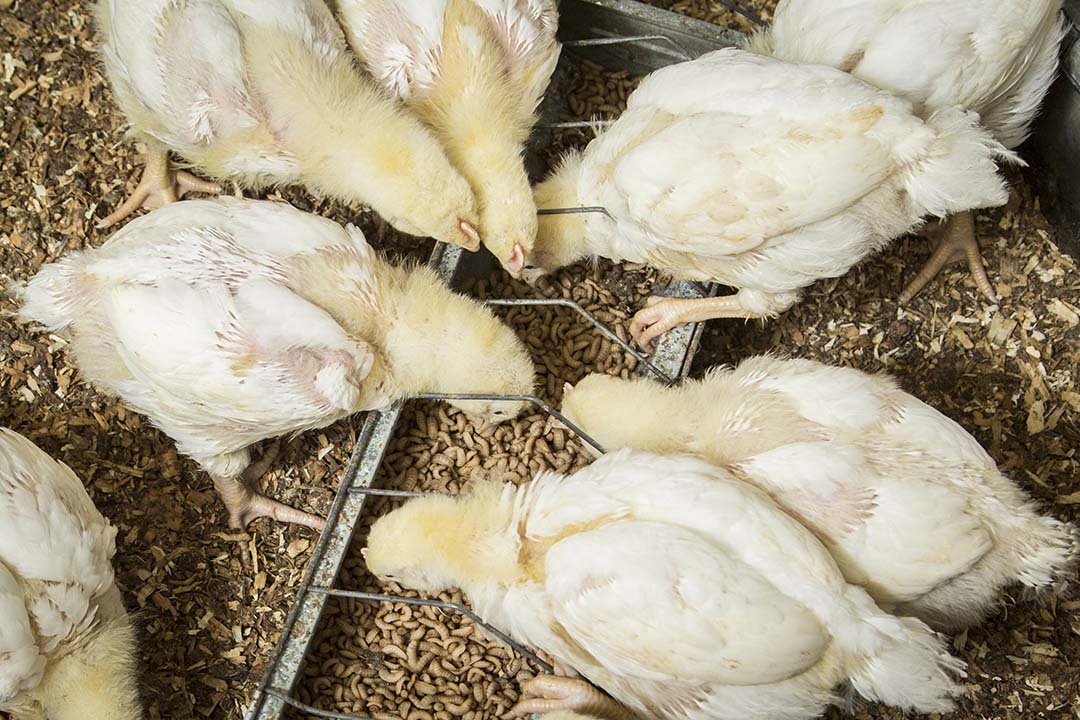Pros and cons of pen enrichment for broilers

Broilers are often kept in houses where they only have access to litter. Pen enrichments are used in some systems but until recently their actual effect had not been scientifically proven. Wageningen University and Research looked into environmental enrichment and found pros and cons. They stimulated activity but resulted in reduced growth and poorer feed conversion.
Poultry farmers rarely use environmental enrichment, especially with conventional broilers, despite its potentially positive effects on chick welfare and leg health. Environmental enrichment, such as adjustable perches, straw bales or other roughage, an increased distance between the feed and water lines, and elevated grid floors (platforms), can stimulate the activity of broilers. Increased activity can have a positive effect on broiler leg health (footpad lesions, hock dermatitis, lameness). The effects of environmental enrichment on their activity vary between studies. This may be related to factors such as the breed, growth rate and the amount of enrichment.
Leg health is partly related to the growth rate of broilers. Higher growth rates increase the risk of leg disorders. Therefore, it is possible that environmental enrichment has a greater effect on leg disorders in conventional broilers than in slower-growing broilers. Wageningen University and Research conducted an experiment to investigate the effect of environmental enrichment on growth and leg health in both conventional and slower-growing broilers.
Experiment
The research team distributed 420 Ross 308 and 420 Hubbard JA 757 day-old chicks among 28 pens measuring 3 x 1 m. Each pen housed either 30 Ross or 30 Hubbard male chicks. For both breeds, half the pens were enriched, while the other half only had a non-adjustable perch. The enriched pens had 5 types of enrichment:
- The distance between the feed trough and the water nipples was 3 m instead of 1 m
- The team placed a slope with a platform on both long sides of the pen
- They created a foraging area with turf in the middle of the pen
- They placed adjustable perches on both sides of this foraging area
- They provided live soldier fly larvae once a day in the foraging area
The Ross chicks were kept until day 38, and the Hubbard chicks until day 49. The temperature in the poultry house was 34°C upon placement and decreased to 18°C from day 25 onwards. On the day of placement the chicks had 24 hours of light, followed by 20 hours for the next 6 days, and then 18 hours of light per day. The chicks were vaccinated against infectious bronchitis upon placement and against Newcastle disease on day 11. Chicks were fed ad libitum with a commercially available 3-phase feed programme.
As the chicks in the enriched pens received soldier fly larvae, the chicks in the non-enriched pens were compensated with a mix with a similar composition. The research team provided this mix in addition to the regular feed at the same time as the larvae were provided in the enriched pens.
Measurements
The team weighed chicks individually upon placement and then weekly. They determined the feed intake on these days as well and they calculated the feed conversion ratio for days 0-14, 14-35, 35-49, and the entire growing period. On days 8, 22, 29 and 43, the behaviour of the chicks was scored and their use of different forms of enrichment was observed. On day 27 the researchers assessed the gait score for 4 Ross chicks per pen and did the same on day 35 for the Hubbard chicks. On average, chicks from both breeds had the same weight at that time.
On day 38 (Ross) and 49 (Hubbard), 2 chickens per pen with similar weights were euthanised. The researchers then assessed the left leg for deviations such as varus-valgus, bacterial chondronecrosis with osteomyelitis, epiphyseal growth plate abnormalities, epiphysiolysis and footpad lesions. They removed the tibia from the right leg and evaluated it for length, thickness, volume, mineral content and mineral density. Then they broke the same tibia to determine the force required to do so. A higher mineral content and a higher force needed to break the bone indicated better bone development and ability to support the chick’s weight.

Results
From day 21 onwards chicks in the enriched pens had lower weights than the chicks in the non-enriched pens. On day 35 the average difference (Ross plus Hubbard chicks) was 99 g, while for Hubbard chicks on day 49, this difference was 93 g (see table). The feed intake did not differ between the enriched and non-enriched pens, which means that the feed conversion ratio between days 0 and 35, on average, was 5 points higher for the enriched pens (for both Ross and Hubbard chicks) and 6 points higher between days 0 and 49 (for Hubbard chicks only).
The reason the enriched pens had a lower growth and a higher feed conversion ratio may be attributed to the complexity of the enrichments. It may have simply been too much. Another reason may be that the elevated perches, which the chicks had to cross to move from feed to water, were too high or there were too many other chicks sitting on them blocking their passage.
Both the Ross and Hubbard chicks in the enriched pens exhibited more foraging behaviour and less aggressive behaviour than the chicks in the non-enriched pens. Additionally, both breeds in the enriched pens utilised the enrichments equally, with Ross chicks spending more time under the platforms and Hubbard chicks spending more time on the platforms and perches. This means that when provided, environmental enrichment is effectively utilised by both conventional and slower-growing chicks.
Leg problems were rare in both the Ross and Hubbard chicks and the percentage of birds with leg problems did not differ between the enriched and non-enriched pens, or between the 2 breeds. When looking at the tibia, the research team found minor differences between chicks in the enriched and non-enriched pens, with chicks in the enriched pens having tibia with a larger volume. There was no difference in weight, mineral density or breaking strength of the tibia between the chicks in the enriched and non-enriched pens. However, at the same slaughter weight, the tibia of the Hubbard chicks was better developed for almost all characteristics compared to the tibia of the Ross chicks.
Meeting needs
The use of different forms of environmental enrichment in both conventional and slower-growing broilers demonstrates that it meets the chicks needs. Providing environmental enrichment stimulated activity in both breeds but resulted in reduced growth and poorer feed conversion. Bone quality was better in the slower-growing chicks compared to conventional chicks, but no reduction in leg problems was found. Leg problems were already infrequent.












